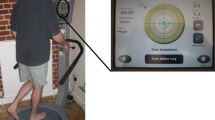Summary
In the present study we evaluated proprioceptive capabilities of the knee joint with a balance test and correlated these findings to parameters which document mechanical stability. We compared 8 conservatively treated and 12 surgically treated patients with ACL-deficient knee joints with a control group of 12 subjects. The balance test was performed with a Kistler force plate. Both the conservatively treated and the surgically treated patients showed significantly higher deviations of their centre of gravity than the control group. This was true not only for the injured leg but also for the noninjured contralateral leg. The differences were most remarkable when comparing the entire distance of centre of gravity deviations during 10 s. Additionally, the conservatively treated patients interrupted the test procedure significantly more frequently than the other two groups. We were not able to document any correlation between proprioceptive function and parameters for joint stability such as anterior drawer, Lachman, pivot shift and KT-1000 measurements.
Clinical significance: In patients with conservatively or surgically treated ACL tears the rehabilitation of proprioceptive capabilities is mandatory both for the injured leg and for the noninjured contralateral leg in order to restore the function of the lower extremities. Reconstruction of passive stability alone is not sufficient.
Zusammenfassung
In der vorliegenden Untersuchung wurden propriozeptive Fähigkeiten des Kniegelenkes mit Hilfe eines Einbeinstandtests und einer Schwerpunktanalyse evaluiert und mit Parametern der mechanischen Gelenkstabilität korreliert. Ein Kontrollkollektiv von 12 Probanden wurde mit 8 konservativ und 12 operativ behandelten Patienten nach vorderer Kreuzbandruptur verglichen. Mit Hilfe einer Kistler-Platte wurden die Abweichungen des Schwerpunktes beim Standversuch aufgezeichnet. Sowohl die konservativ als auch die operativ behandelten Patienten zeigten signifikant größere Schwerpunktschwankungen als die Probanden der Kontrollgruppe. Dieses ließ sich nicht nur für das verletzte, sondern auch für das gesunde Bein nachweisen. Der Unterschied wurde bei den konservativ behandelten Probanden besonders deutlich bei der Analyse der zurückgelegten Strecke innerhalb von 10 s. Darüber hinaus mußten die konservativ Behandelten den Einbeinstand signifikant häufiger abbrechen als die Kontrollgruppe. Es fanden sich keine Korrelationen zwischen mechanischen Stabilitätsparametern (vordere Schublade, Lachman-Test, pivot-shift, KT-1000) und propriozeptiven Fähigkeiten.
Klinische Relevanz: Die Wiederherstellung der koordinativen Fähigkeiten nach Verletzungen des vorderen Kreuzbands (VKB) muß sowohl nach konservativer als auch nach operativer Therapie unbedingt angestrebt werden, um die Funktion des Kniegelenkes zu gewährleisten. Die alleinige Rekonstruktion der passiven Gelenkstabilität reicht hierzu nicht aus.
Similar content being viewed by others
Author information
Authors and Affiliations
Rights and permissions
About this article
Cite this article
Jerosch, J., Schäffer, C. & Prymka, M. Proprioceptive abilities in patients with conservative and surgical treatment of ACL tears. Unfallchirurg 101, 26–31 (1998). https://doi.org/10.1007/s001130050228
Published:
Issue Date:
DOI: https://doi.org/10.1007/s001130050228




